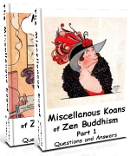Buddhism China - Overview
Zen Riddle #18-lotus :
Why is the lotus leave round, round like a mirror?
Here's the answer....(Show/Hide)
Want more riddles? Choose one!
#19-nut #32-free #33-death mumonkan
Buddhism was first called "dhyana" in China, a Sanskrit word transliterated as "Channa" or Chan. As a new religion Chan had a slow start only in the north of China, but slowly flourished for nearly 1000 years in the whole country.
 Buddhist Mantra
Buddhist Mantra
Buddhism was first brought to China by Indian merchants who practiced Bhuddist meditation. It took a few hundred years until Buddhism was recognized by China's intellectual elite, mainly by Taoists. They saw it as a new religious and philosophical concept very close to Taoism.
After Kumarajiva, in 4th century CE, made the first reliable translations of Buddhist sutras using Taoist terms and thinking Buddhism was finally appreciated by Chinese intellectuals as Chan.
Since 6th century Chinese monasteries translated a constant flow of Buddhist scriptures from India. Although there were other Buddhist groups in China, Chan was dominant.
The contents of Buddhism widely discussed, commented on and compared mainly with the Taoist canon. That's no surprise. Taoism and Buddhism favor non-violence. Both are celebrated as religion and/or as philosophy and both strongly recommend meditation.
Despite this overall acceptance in China, some Confucian scholars trained as state-administrators opposed Chan-Buddhism as a foreign religion.
During the Tang dynasty from the 7th to 9th century CE Chan-Buddhism fascinated the Taoist elite. Buddhism seemed similar to Taoism: Chan, although from India, had no gods and it's intense meditation was the tool to realize the "emptiness" of reality. There was nothing to achieve.
An attractive concept for Taoists. after several centuries Chan-Buddhist abbots, temples and monasteries became politically influential and rich.
Starting in 845 CE, when the Tang Dynasty was already weakened, Chan-Buddhism was heavily suppressed and nearly extinguished by Tang Emperor Wuzong.
The wealth of 40,000 temples and 4,600 monasteries was taken away.
More than 300,000 monks and nuns of Chan were sent to work in the fields and had to pay taxes again.
A fortune for the emperor.
Some lucky Chan-Buddhist monks and nuns escaped to the south, where Chan-Buddhism was still tolerated.
 Buddhism in China
Buddhism in China
Its first emperor, Taizu, a former general, modernized the country.
He and his successors expanded the administration and encouraged new technical ideas and cultural diversity.
The dynasty needed lots of educated civil servants for its reform projects but there were not enough qualified applicants.
Buddhist competition with Confucians.
By the 10th century the flow of Buddhist scriptures from India had dried .
Chan monks learned to cultivate themselves through meditation until they reached the state of enlightenment.
This process was claimed to be similar to Confucian studies with an imperial examination at the end.
Buddhist leaders argued that both ways similarly enabled their successful students to take over government posts. After some time the emperor agreed.
 Buddhist Beliefs
Buddhist Beliefs
Neo-Confucianism became less elitist, more egalitarian.
Chan-Buddhism became less mystical, more pragmatic and focussed on meditation.
Today, after 200 years of social and political changes Chinese Chan also called meditation Buddhism is still best known as "Zen" around the world. This might change one day.
The transformation of Indian Buddhism to Chinese Chan Buddhism wasn't smooth at all.
Chan Buddhism since 6th century split into different Chinese schools, so called houses.
 Chan Word
Chan Word
All these forefathers, it was said, were linked in a very long chain of enlightened predecessors to the Enlightened One, the Buddha.
This fictional genealogy, the so called "lineage", provided the Buddha's authority to all Chan schools since first century CE in China.
Some Chan masters who were linked to the "lineage" could make their students eligible for government jobs by approving their enlightenment.
This system made some master powerful and guaranteed them a constant flow of income.
 Zen Saying
Zen Saying
Buddhism was in China still seen as a foreign cult. This image had been the main reason for several persecutions.
To change this perception Chan cut off its roots and converted the "Indian" Buddha and his teachings (the sutras) into a Chinese version.
The Chinese Buddha behaved like Lao Tzu, Kung Fu-Tze (Confucius) or any other ancient Chinese philosopher.
The mysticism and magic of Buddhism was strictly denounced. Enlightenment and how to achieve it without magic became the new center of Buddhist teaching in China.
The transition to Chinese Chan Buddhism wasn't officially declared but told in hundreds of stories.
Drawn from widely known fairy tales, legends and popular sayings, strange habits of deceased Buddhist masters were reported or newly created.

Zen Wisdom
The tricky strategy to change Buddhism into Chinese Chan was successful. The outcome, a fictional history is believed as real in most Chan circles until today.
The often lengthy biography-stories of Zen were later shortened and called goang like the philosophical cases Confucian students had to deal with.
Buddhist goang collections, the well known Chan riddles became the text book of Chan.
Although there were still pockets of other Buddhist schools during the Song dynasty, Chan was dominant in China.
But in the following centuries Chan slowly merged with Confucianism and Taoism.
Japanese monks who came to study Buddhism China in the 13th century not only mispronounced the characters for "Chan" as "Zen", but also took the fictional Zen stories at face value as historical riddles with a mystical meaning.
Go to Buddhism China Stories
Go to Buddhism History
Return to Home Page



